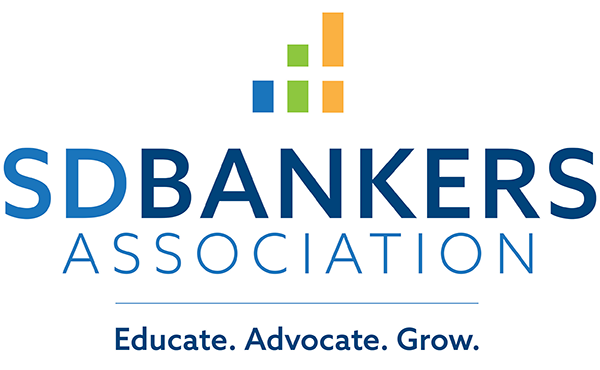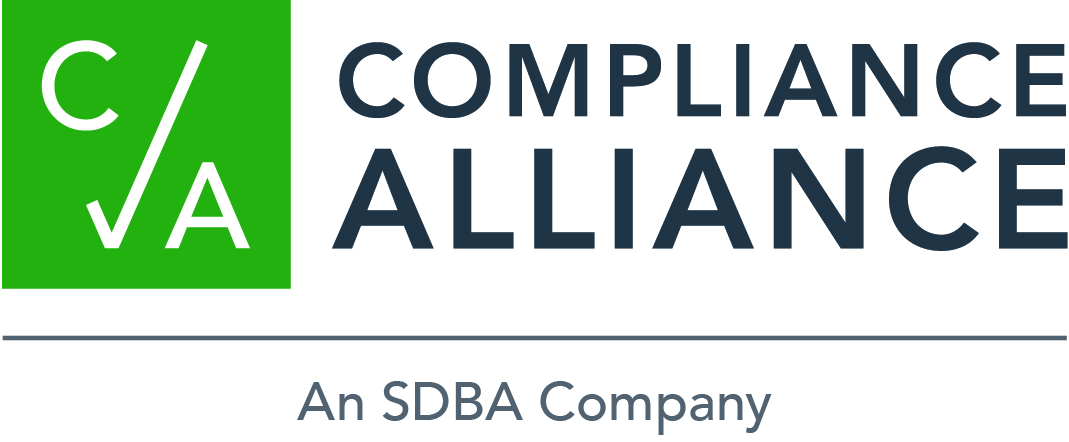- Education & Events
- Advocacy
- Products & Services
- Membership
- Resources
- SDBANKER Magazine
- SDBA eNews
- SDBA eNews Archives
- Legislative Update/Bill Watch
- South Dakota Bank Directory
- Women in Banking
- Scenes of South Dakota Calendar*
- Holiday Signs
- Regulatory Report
- South Dakota Banking Code
- Record Retention Manual
- Advertising & Sponsorship Guide
- COVID-19 Resources
- Mental Health and Crisis Prevention
- About
|
Governor Noem Asks for Bankers Support of County Zoning Bill
While addressing attendees, Gov. Kristi Noem asked for the banking industry's support of Senate Bill 157. Introduced by the State Affairs Committee at the Governor's request, the bill would revise certain provisions regarding the county zoning and appeals process. Noem said the bill sets up the structure and skeleton for how county zoning and appeals proceedings are handled, but does not take away local control or the ability for counties to set their own criteria. "I want you to know my reason for bringing this bill. We have got to grow our economy in South Dakota. We have had a good 10-year period where we have not been growing," Gov. Noem said. "We need to make sure that every corner of our state has the opportunity to keep their small towns going, their main street businesses going, that their farmers and ranchers can keep their kids and grandkids on their operations. You do that and you create a business environment by having it be fair." Earlier in the day, the SDBA Legislative Committee agreed that the SDBA will support bill. Read the bill. Be watching for more information on the bill in SDBA President Curt Everson's Legislative Update on Friday. SDBA Unveils Annual Banks Make a Difference Survey
Each January, the SDBA surveys its member banks and collects data on the importance of banks to their local communities and to the state as a whole. The annual project is just a glimpse of how banks work every day to help South Dakotans grow and prosper. The document is a great tool that banks can use to promote all of the things they do for their communities. Banks are encouraged to use the document in their promotional efforts, make copies as needed and link the document on their websites. Banks can also download a high-resolution copy for printing.
ABA Highlights Banks' Progress in Diversity, InclusionIn testimony before a House Financial Services subcommittee yesterday, ABA SVP Naomi Mercer highlighted the strides banks have made toward building a more diverse, equitable and inclusive workforce and discussed some of the challenges they face in this area. “Our member banks run the gamut of diversity, equity and inclusion,” Mercer said. “Many have robust DEI programs and have implemented leading practices such as employee resource groups, leadership and formal mentoring programs to advance women, people of color and other represented groups, and supplier diversity programs.” Mercer also noted that many banks face challenges with recruiting qualified individuals to fill senior leadership positions. Other smaller firms face the challenge of being located in geographic areas with less racial and ethnic diversity, she said, emphasizing the importance of recognizing other aspects of diversity, such as gender, individuals living with disabilities, LGBTQ+, religious affiliation, veteran status or socio-economic class. “These aspects of identity and background add to the diversity of thought that banks need and want to develop.” Mercer acknowledged that more progress can be made to increase the overall diversity of the financial sector—a key finding of a report released by the Financial Services Committee earlier this week. The report found that workforce diversity demographics among the largest banks mostly aligned with the composition of the broader U.S. labor force, but that diversity was more visible at the entry level than in senior level positions. Read Mercer’s testimony. Read the report. ABA Releases Core Provider Information, Banker AnalysisIn the latest update from ABA’s banker-led Core Platforms Committee, the ABA on Monday shared information it has received from four major core processors as well as an analysis of the cores’ responses by bankers on the committee. During the course of in-person meetings and a questionnaire, Finastra, FIS, Fiserv and Jack Henry provided information about their current offerings and future plans, particularly in the committee’s priority areas of data access, APIs and contract fairness. The member analysis provides the committee’s aggregated observations about the cores’ collective responses. “We believe these documents can help you as you assess your bank’s core needs moving forward,” ABA President and CEO Rob Nichols said at ABA’s Conference for Community Bankers in Orlando, Florida. Nichols added that the committee has met with other cores in the market and will soon meet with emerging core providers, and more information from those meetings will be shared at the ABA Washington Summit, March 25-27 in Washington, D.C. Access the documents at aba.com/core. Register for the Summit. ABA Publishes Letter Writing Guide to Assist with CRA CommentsWith the March 9 comment deadline for the FDIC and the OCC’s proposal to modernize the Community Reinvestment Act regulations fast approaching, ABA has compiled a comment letter writing guide to help bankers draft their comment letters. This members-only resource highlights several key aspects of the proposal—such as assessment areas, performance measurement and data collection—that bankers could respond to in their comments. ABA encourages bankers to provide specific examples in their comment letters of how the proposal will affect their institution and to consider including their own recommendations for improving the CRA regulatory and supervisory framework. The guide also provides instructions for filing comment letters once completed. Access the guide. For more information, contact ABA’s Krista Shonk. Podcast: Global Correspondent Banking at a U.S. Community BankWith $1.57 billion in assets, HAB Bank isn’t big—but it’s a community bank with global reach. The New York-based institution provides correspondent banking services for 140 banks in 20 countries, primarily in South Asia and East Asia. On the latest episode of the ABA Banking Journal Podcast, sponsored by Franklin Madison, President and CEO Saleem Iqbal discusses how HAB Bank competes in this global marketplace. Iqbal talks about HAB Bank’s 45-person correspondent banking unit, in which one-third are devoted to compliance. “We embraced every single change in regulation, and we’ll tailor our business model to the regulatory environment,” he says. As part of the bank’s due diligence, for example, HAB Bank employees visit its correspondent bank customers overseas twice a year. Iqbal also discusses the bank’s commercial real estate lending business, which focuses on tenanted commercial properties in New York City, New Jersey and Southern California, as well as its trade finance activities and Iqbal’s involvement in ABA’s Community Bankers Council. Listen to the episode.
ABA Seeks Bank Responses in Economic Impact SurveyFollowing the success of an interactive map on the America’s Banks website quantifying the economic impact of America’s banks, ABA has launched a new survey to update key data so that the map can retain its value. Since its debut, the map has been shared with lawmakers and the public through digital and social media campaigns—and has proven to be a powerful way to demonstrate for decision-makers the important role banks play in their districts and states. The survey—which has been sent via email to all CEOs—asks for updated bank data, including the institution’s footprint, constituent impact, taxes, loans, investments and other contributions. Banks are asked to submit their data to ABA by Feb. 24, 2020. View the map. For more information and to participate in the survey, contact ABA’s Afifa Klouj. Losses from Romance Scams Increased in 2019, FTC FindsConsumers lost $201 million to romance scams in 2019, an increase of nearly 40% from a year prior, according to new data from the Federal Trade Commission’s Consumer Sentinel Network. The FTC received more than 25,000 reports about romance scams in 2019—nearly triple what the agency received in 2015. The ABA Foundation and the FTC previously highlighted the common signs of romance scams in an infographic that banks are free to use to educate their customers. Such scams typically involve a fraudster creating a fake profile to lure in victims, establishing a romantic relationship and eventually extorting money from their victims, which frequently include older Americans. In cases where an online romance scam is suspected, the ABA Foundation and the FTC recommend that consumers slow down and talk to someone they trust, never wire money or send cash in any way to an online love interest, contact their bank immediately if they feel they’ve sent money to a scammer and report the experience to the online dating site, the FTC and the FBI. Read more. View the infographic.
|
|
|
|


 Bankers from across the state gathered in Pierre yesterday to network with each other, state legislators and constitutional officers at the SDBA's State Legislative Day. The annual event is an opportunity to stay up-to-date on both state and federal legislation which could affect the banking industry and make sure our industry is heard.
Bankers from across the state gathered in Pierre yesterday to network with each other, state legislators and constitutional officers at the SDBA's State Legislative Day. The annual event is an opportunity to stay up-to-date on both state and federal legislation which could affect the banking industry and make sure our industry is heard. The SDBA unveiled the latest results of its Banks Make a Difference Survey during its State Legislative Day yesterday in Pierre. Copies of the
The SDBA unveiled the latest results of its Banks Make a Difference Survey during its State Legislative Day yesterday in Pierre. Copies of the 

